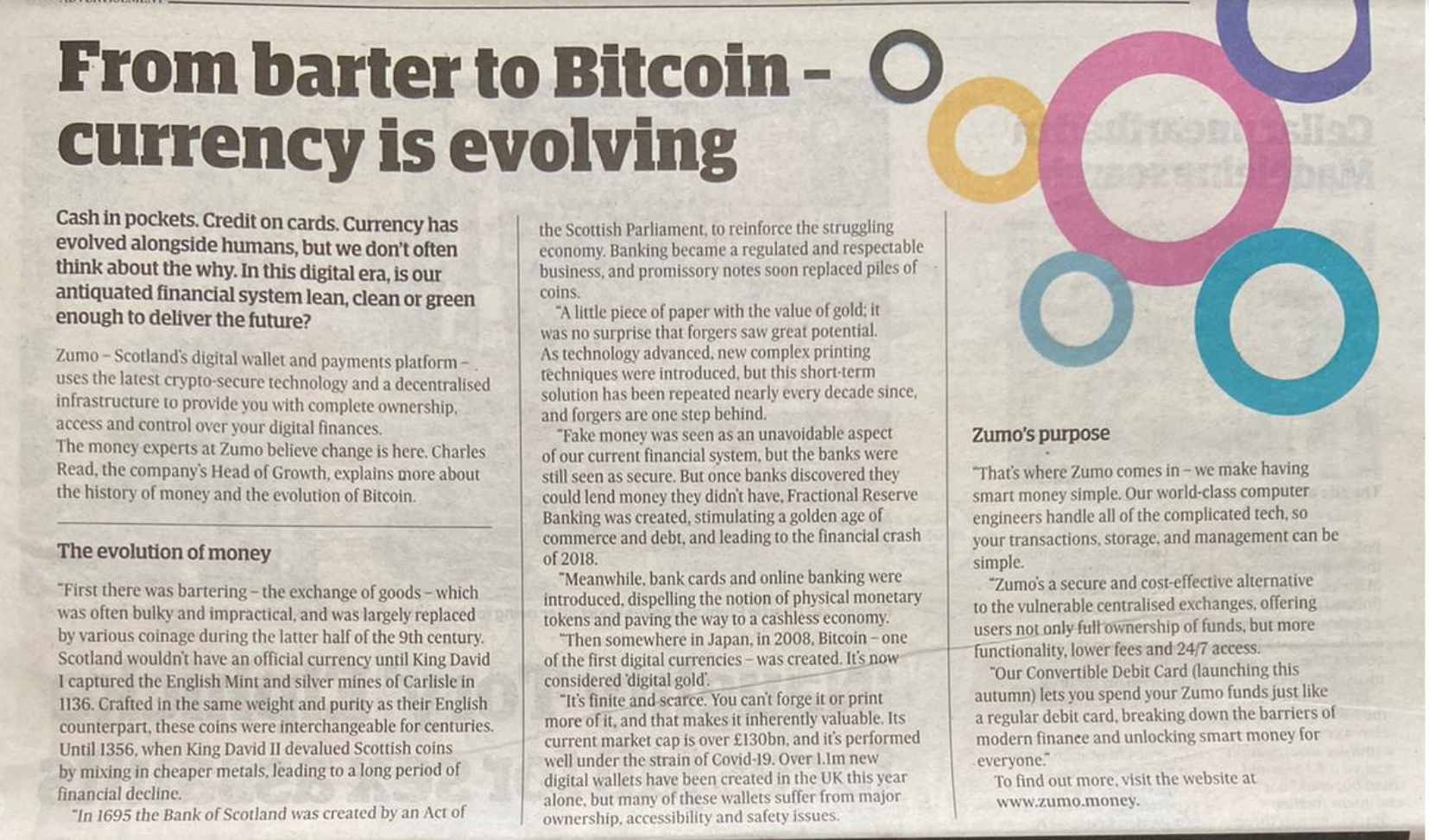The original whitepaper for Bitcoin, the first cryptocurrency, pioneer of blockchain technology, and world-changing concept, stated the intention very clearly: Bitcoin meant a digital alternative for cash. Eleven years later, however, Bitcoin is still everything but cash (for most).
Bitcoin, for some, is a long-term investment. For others, it is a highly-volatile financial instrument or a concept that represents an ideology of decentralisation. There is, however, a fourth category: Those that believe in the original idea of cryptocurrencies as digital, borderless, permissionless alternatives to money.
To talk about the daily effort of creating an ecosystem where everyday payments happen thanks to cryptocurrencies and the blockchain, we invited Nick Jones, CEO and Founder of Zumo, a UK-based fully decentralised mobile wallet and payments platform. Zumo’s mission is “to democratise the access to crypto and normalise it by making it useful in everyday situations,” making Nick the ideal person to explain how crypto payments are to happen, and what has, so far, stalled this process.
The road ahead.

Nick Jones (CEO, third from left to right) with the rest of the Zumo team in Edinburgh.
It is no surprise to hear that, for most people, cryptocurrency is still an obscure, complex concept that, despite being more cost-efficient than its traditional alternatives, is still unknown or avoided by most. However, for Nick, the barriers that separate cryptocurrency from mainstream use are not 100% about complexity. According to him, 60% out of the general population surveyed by Zumo in Scotland demonstrates at least a basic interest in learning, understanding, and using cryptocurrencies. Nick also cites the following factors as entry barriers for everyday citizens into the crypto space:
- The complexity of platforms and bad design: A common factor quoted by developers in this space is the need to eradicate the feeling of sophistication in blockchain. Platforms that are used by users every day should be simple, well designed, and friendly to have a chance to be widely adopted.
- The story at the centre of cryptocurrencies and blockchain: Early enthusiasts of the space are familiar with its values. However, these values do not seem immediately apparent to those outside of the ecosystem. Adoption needs to happen thanks to this message, and it should be the primary focus of those aiming to drive it.
- An economic establishment that’s reluctant or unwilling to change: A blockchain-based financial ecosystem has the potential to replace the existing one fully. Of course, a revolution and fundamental change such as this would have repercussions and ramifications through all layers of society, causing the powers that be to be extremely cautious and, in some cases, actively discourage regulation or adoption.
- Momentum: In a fast-paced world, users tend to expect the adoption and implementation of new technologies to happen extremely quickly. Reality, in this regard, has shown us the need to build momentum to push new ideas forwards with higher speed.
Crypto for traders vs crypto for savers

Zumo, surprisingly, found that local print media was better for driving adoption to their product than digital resources.
Another point that Nick stresses is that the adoption of cryptocurrencies as money does not often go hand in hand with their adoption as volatile instruments for traders. So, while prolonged periods of very low volatility can encourage adoption for payments, the more experienced users might be deterred by a lack of opportunities to cash out exciting trades.
Zumo’s CEO considers that being able to offer options for users to manage their money thoroughly, through “savings against Bitcoin”, “savings against Ether”, and stablecoin accounts, along with payments using well-known coins, will be vital to guarantee users’ future tranquillity. Crypto platforms, in this way, can present users with ways to engage in different levels of conservative or high risk-taking, within the same application they use for everyday transactions.
Growing a user base, day after day
As we finish this article, we can say that by researching adoption and everyday payments, we uncovered insights that can be useful for institutional investors looking into the crypto space. Some of these are:
- Trends dictate the way: Bitcoin was created as a response to the 2008 economic crisis. As we move through yet another crisis, this time with a different cause, many users, investors, and even Zumo report growth in the interest in Bitcoin and cryptocurrencies.
- Blockchain to regulate blockchain: The blockchain, Nick says, is “the ideal technology for a global payment system”. This technology nonetheless has to be implemented within its own regulation to eliminate the risk for the negative downside a permissionless global system could have.
- Decentralisation starts at a local level: Countries facing hyperinflation have advanced their adoption of cryptocurrencies faster than others. Since the need for solutions drives faster adoption, helping communities with potential for success (i.e. savvy users) and with particular needs should be the #1 thing an investor should look for. For example, DeFi provided tech-savvy users with a way to participate in lending and borrowing without going through the traditional finance system. Early adopters are essential to attracting the masses since happy users are the best advertisers.
- Thinking outside the box is always rewarded: Nick quotes advertising in print media in Scotland’s tech hubs as one of Zumo’s greatest successes. ‘We could not currently compete on advertising with the Coinbases and Binances of the world’ he says ‘so we decided to go to for the market that they aren’t trying to capture’. In the end, as it’s always in business, resourcefulness builds unexpected leverages where there weren’t.
To keep receiving stories such as this and access more content, please consider a free subscription to D-Core’s platform!